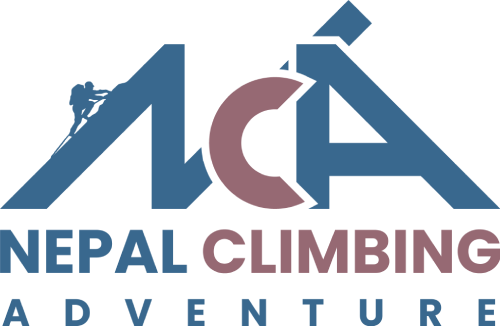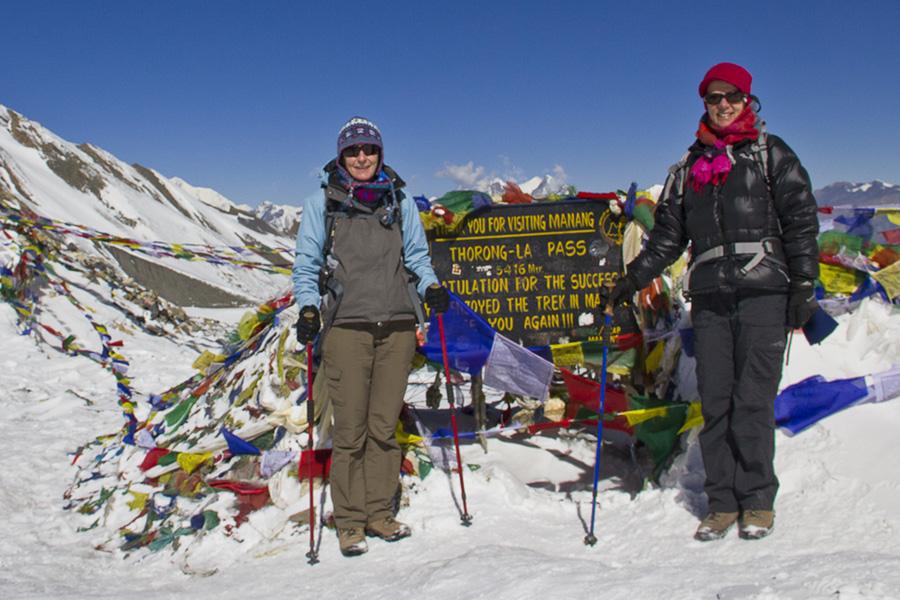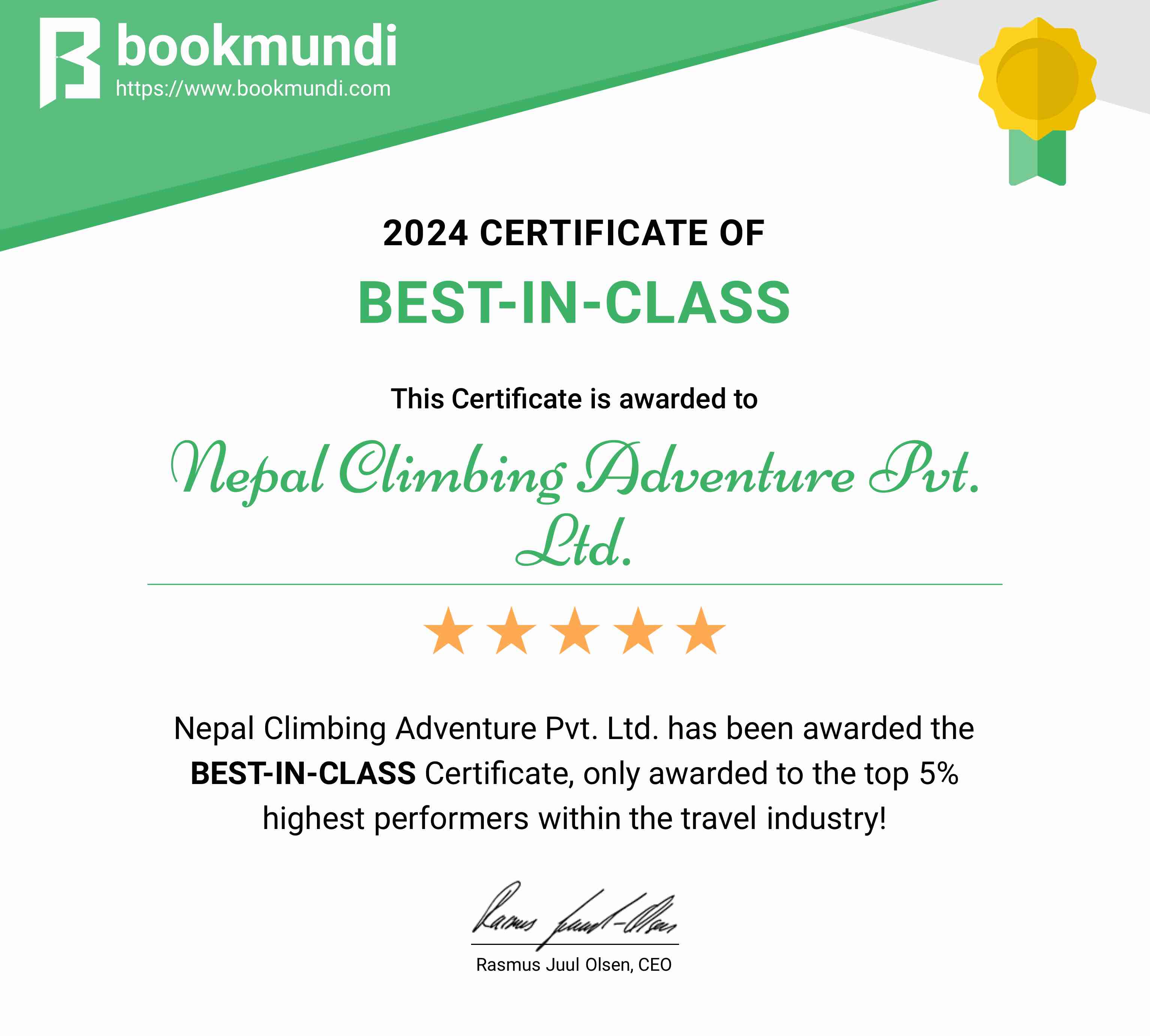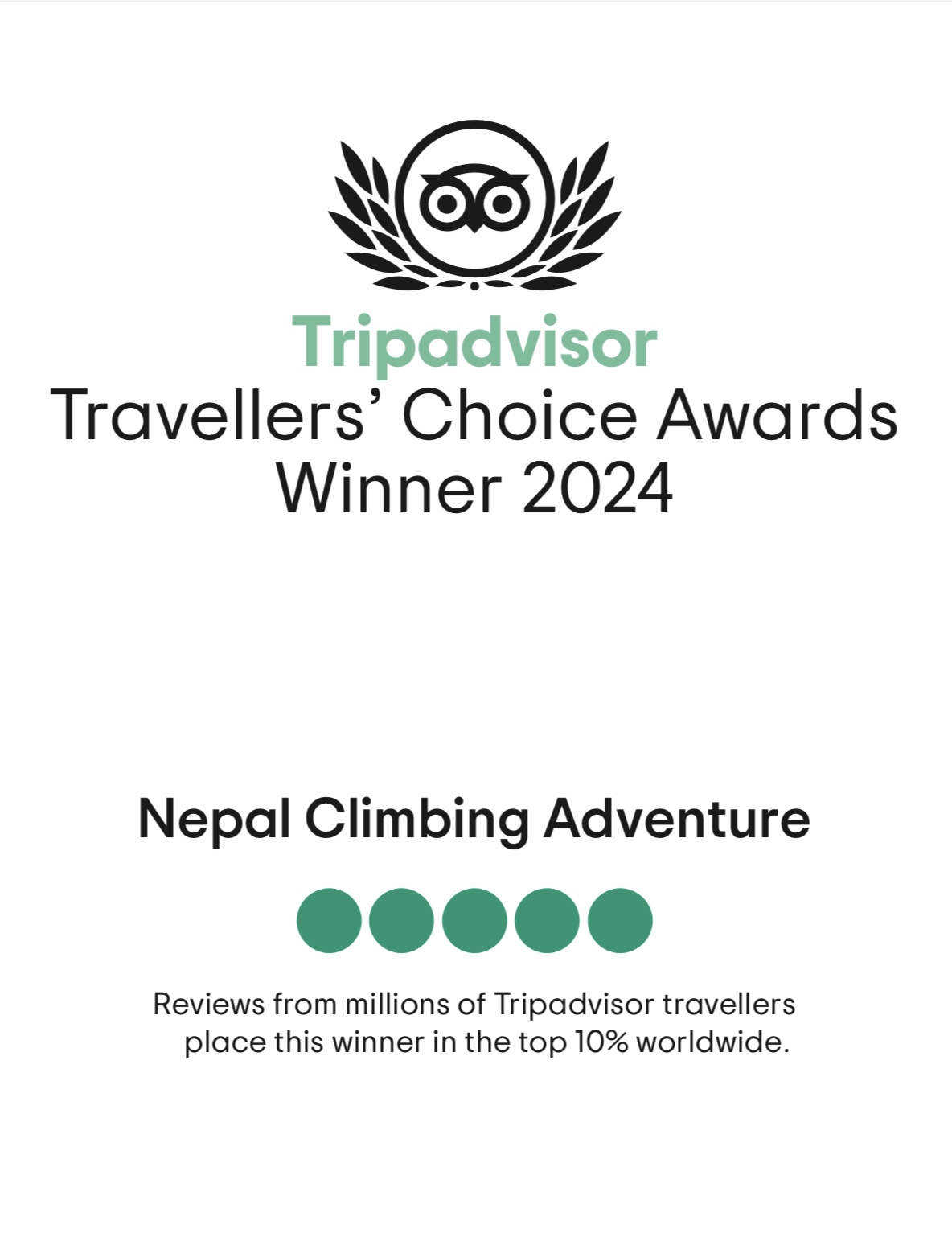Overview:
The Annapurna Circuit Trek is renowned as one of the most spectacular trekking experiences in the world. This 15-day Annapurna Circuit Trek adventure takes you on a journey around the majestic Annapurna mountain range in Nepal, offering a diverse range of landscapes and an immersive cultural experience. Also known as the Round Annapurna Trek, this route spans approximately nine days and covers a variety of terrains, from lush valleys to high-altitude passes. The Circuit trek to Annapurna begins in the lush subtropical forests of the lower river valleys. As you move forward, you gradually ascend through terraced fields and traditional villages. The trail offers panoramic views of the Annapurna and Dhaulagiri ranges, with their snow-capped peaks standing majestically against the sky. One of the most significant Annapurna Circuit highlights is crossing the Thorong La Pass, which sits at an altitude of 5,416 meters (17,769 feet). The Annapurna Circuit trek distance spans approximately 160 - 230 kilometers, offering a challenging yet rewarding journey for avid trekkers.
This high mountain pass is one of the highest trekking passes in the world, and reaching it is a notable achievement for trekkers. The Annapurna Circuit Trek is known for its diverse environment. The trek takes you through different climatic zones, allowing you to experience the transformation of the environment from subtropical to alpine to desert-like conditions. The trek to annapurna circuit is challenging and requires good physical fitness due to the high altitude and the demanding nature of the terrain. The ascent to Thorong La Pass is particularly strenuous, and trekkers may experience altitude sickness if not properly acclimatized. The lower Annapurna Circuit elevation feature lush greenery and warm temperatures, while higher altitudes reveal arid, high-altitude landscapes with dramatic views of the surrounding peaks. However, the breathtaking scenery and the sense of accomplishment upon completing the trek make it a highly rewarding experience.
In addition to the natural beauty, the Annapurna Circuit trek offers a unique opportunity to experience the local culture. You’ll pass through traditional villages inhabited by the Gurung, Magar, and Tibetan communities. These villages provide insights into local customs, traditions, and lifestyles. Visiting monasteries and interacting with the friendly locals adds a cultural dimension to the Annapurna Circuit adventure. Trekking the annapurna circuit is celebrated for its combination of stunning natural beauty, diverse landscapes, and rich cultural experiences. The Annapurna Circuit is a journey that challenges and rewards trekkers, making it one of the most popular and revered trekking routes in the Himalayas. If you are prepared for the physical demands and eager for an unforgettable adventure, this trek is a true Himalayan classic.
An Excellent Blend of Culture and Adventure
While Trekking Annapurna Circuit, you will experience the incredible culture and adventure of the region. As you walk past several beautiful villages along the trail, you can enjoy the lifestyle and culture of the people living there. From the lower river valley lifestyle to the high mountain cultures, you will experience diverse cultural riches.
The trek also takes you to the highest elevation of Annapurna Circuit region. A high mountain pass – Thorong La – that stands at the elevation of 5416 meters above sea level is a challenging pass to cross. But the most adventurous Annapurna Circuit highlights is the early morning walk towards the pass to cross it. The walk that starts in the Marshyangdi River valley ends in the Kali Gandaki River valley. And the Annapurna trekking circuit experience in between is simply unearthly. You will also visit and explore the famous pilgrimage of Muktinath. Our Jomsom Trek takes you there from a different route.
For you to make this trip easier, our comprehensive Annapurna Circuit Trek map guides you through every scenic trail and hidden gem of this iconic trek. Fresh mountain air, beautiful natural surroundings, and views of the mountains also add to the beauty of this trek. You can enjoy the view of massive mountains like Annapurna, Dhaulagiri, Manaslu, Tukuche, Fishtail, etc.
You can also check our Annapurna Sanctuary Trek if you are looking for multiple options to choose from.
Reasons this trip becomes an Experience
Nepal Climbing Adventure always strives to offer an adventure traveling experience that you can cherish. While trekking the annapurna circuit is beautiful in its all essence, your experience of trekking there becomes even more beautiful with us.
By the time we take you to the base camp and bring you back, we take one step ahead to offer you a beautiful experience. We keep your safety and happiness as our top priority and you will experience the same during the trip. Experience the ultimate adventure with our Annapurna Circuit Trek package, offering breathtaking views and unforgettable moments.
This 15-day Trekking trip around the Annapurna with us is traveling in safe hands.
Highlights for the Annapurna Circuit:
- Experience a stunning range of environments, from lush subtropical forests and terraced fields to arid high-altitude deserts.
- Explore traditional villages of different ethnic communities, including Gurung, Thakali, and Manangi, with their unique customs and architecture.
- Marvel at panoramic views of the Annapurna and Dhaulagiri mountain ranges, including iconic peaks like Annapurna II, Annapurna IV, and Machapuchare.
- Conquer the high-altitude Thorong La Pass (5,416 meters), the highest point on the trek, and be rewarded with breathtaking views.
- Relax in natural hot springs at Tatopani, soothing your muscles after long trekking days.
- Visit ancient monasteries and temples, including the Manang Gompa and the Muktinath Temple, significant for both Buddhists and Hindus.
- Encounter a rich variety of plant and animal life, from dense rhododendron forests to unique high-altitude species.
- Enjoy the warm hospitality of local teahouses and guesthouses, experiencing Nepalese cuisine and culture up close.
- Face the physical challenge of high-altitude trekking, with varied terrain and Annapurna Circuit weather conditions adding to the adventure.
- Witness awe-inspiring sunrises over the Himalayas, especially from viewpoints like Poon Hill.
Trek Route:
The circuit trek to annapurna region offers a spectacular journey through a diverse array of landscapes and cultures. Beginning in Kathmandu, the trek follows a route that gradually ascends from the lush, subtropical valleys of the lowlands to the high-altitude deserts of the Tibetan plateau. Travelers traverse through charming villages like Chamje and Dharapani, each with its unique character and culture, and pass through the bustling town of Chame, where the scenery starts to change to alpine forests and rocky trails.
The trek continues to Pisang and Manang, where trekkers gain altitude and acclimatize to the thinning air, with stunning views of the Annapurna and Gangapurna ranges. The challenging ascent to Thorong La Pass, one of the highest trekking passes in the world at 5,416 meters, is a highlight of the trek, offering breathtaking vistas of the surrounding peaks. The descent leads to the sacred site of Muktinath, and eventually, to the wind-swept valley of Jomsom. The journey concludes with a return to Pokhara, a serene lakeside city, before heading back to Kathmandu, reflecting on an epic Annapurna Circuit adventure through the heart of the Himalayas.
Difficulty Level for Annapurna Circuit Trek
The trek to annapurna circuit is a popular trekking route in Nepal, known for its stunning scenery and diverse landscapes. The Annapurna Circuit trek difficulty level of this trek varies depending on several factors, including your fitness level, experience, and the time of year you choose to trek. The trek to annapurna circuit is considered a moderate to challenging trek. The trek covers about 160 to 230 kilometers (100 to 145 miles), depending on the exact route you take. It usually takes around 15 to 20 days to complete, which includes acclimatization days to help you adjust to the annapurna circuit trek altitude. One of the main challenges of the Annapurna Circuit is the high altitude. The trek reaches an elevation of 5,416 meters (17,769 feet) at Thorong La Pass, which is the highest point on the circuit.
This means you will be Trekking Annapurna Circuit at high altitudes where the air is thinner and oxygen levels are lower. Trekking at such heights can lead to altitude sickness, so it’s important to acclimatize properly and listen to your body. Another difficulty is the changing Annapurna Circuit weather. The weather in the Himalayas can be unpredictable, with temperatures ranging from freezing cold at higher altitudes to warm and sunny lower down. Snow, rain, and strong winds can occur, especially during the monsoon season (June to September) and winter months (December to February). The trek also involves a variety of terrain, including steep ascents and descents, rocky paths, and river crossings.
Some sections can be quite strenuous, particularly around the Thorong La Pass. Proper trekking gear, including sturdy hiking boots, warm clothing, and rain protection, is essential. Physical fitness plays a crucial role in your ability to complete the circuit trek to annapurna region. Regular exercise and training before your trek can help you build the stamina and strength needed for the journey. It’s also beneficial to have previous trekking experience, although beginners can still complete the trek with proper preparation and support. The trek to annapurna circuit offers a rewarding experience with breathtaking views and cultural encounters, but it requires good physical fitness, careful planning, and readiness for various challenges.
What makes the Annapurna Circuit Trek special?
The Annapurna Circuit adventure is remarkable and stands out for several reasons. One of its most notable features is its incredible diversity. The trek takes you through various landscapes, from lush subtropical forests to high-altitude deserts. You’ll experience different climates and ecosystems as you move from lowland villages to alpine meadows and stark, high-altitude deserts. Another Annapurna Circuit highlights is the opportunity to immerse yourself in the rich culture of the region. The trek passes through numerous traditional villages where you can interact with local people and learn about their customs and way of life. The circuit also offers breathtaking views of the Annapurna and Dhaulagiri mountain ranges, with stunning vistas at every turn.
The trek is also famous for its unique geographical features. You’ll cross the Thorong La Pass, which is one of the highest trekking passes in the world at an elevation of 5,416 meters (17,769 feet). This challenging pass provides panoramic views of the surrounding peaks and is a significant achievement for trekkers. The Annapurna Circuit is known for its well-established teahouse system. This means you can enjoy comfortable lodgings and delicious meals prepared by local hosts. The availability of teahouses makes the trek more accessible and enjoyable, as you don't need to carry heavy camping gear. The Annapurna trekking circuit is special because it combines diverse landscapes, rich cultural experiences, and stunning natural beauty, making it one of the most popular and rewarding treks in the Himalayas.
15 Days Annapurna Circuit Trek Cost for 2024 and 2025
The Annapurna Circuit trek cost can vary significantly based on factors like trek duration, level of comfort, and the services included. Here’s a cost detail for the 15-day Annapurna Circuit Trek for 2024 and 2025:
Permits and Fees:
- TIMS Card (Trekkers' Information Management System): $10 - $20
- ACAP (Annapurna Conservation Area Permit): $30 - $50
- Local Government Fees: $10 - $20
Guides and Porters:
- Guide (Optional): $25 - $40 per day
- Porter (Optional): $20 - $30 per day
Accommodation:
- Teahouse Lodging (per night): $5 - $10 per person
- Total for 14 nights: $70 - $140
Meals:
- Breakfast, Lunch, Dinner (per day): $15 - $30
- Total for 15 days: $225 - $450
Transportation:
- Kathmandu to BesiSahar (bus): $15 - $30
- Besi Sahar to Chamje (jeep): $10 - $20
- Return to Kathmandu (bus): $15 - $30
Miscellaneous:
- Water and Snacks: $5 - $10 per day
- Total for 15 days: $75 - $150
- Travel Insurance: $50 - $100
Luxury Options:
- Private Transport (Comfortable Vehicle): $150 - $300
- Luxury Lodging (per night): $20 - $50 per person
- Total for 14 nights: $280 - $700
- Upgraded Meals and Services: $200 - $400
Best Time to Hike Annapurna Circuit
The Annapurna trekking circuit is a popular and diverse trek in Nepal, known for its stunning scenery and varied landscapes. Choosing the Annapurna Circuit trek best time to undertake this trek is crucial for ensuring a pleasant experience. Here's a detailed look at the ideal times for trekking the Annapurna Circuit:
-
Autumn (September to November):
Autumn (September to November) is the Best time to hike Annapurna Circuit. During this season, the weather is stable with mostly clear skies. Temperatures range from 10°C to 20°C (50°F to 68°F) at lower altitudes and are colder at higher elevations. The scenery is stunning, with lush green landscapes from the monsoon rains and blooming rhododendron forests. The clear skies offer breathtaking views of the Himalayas. This period is also the peak trekking season, so the trails can be busy with many trekkers. Despite the crowds, the vibrant atmosphere and the range of available services make autumn a popular choice for this trek.
-
Spring (March to May):
Spring (March to May) is another great time for the Circuit trek to Annapurna region. The weather is generally stable, with temperatures ranging from 15°C to 25°C (59°F to 77°F) in the lower regions and cooler at higher elevations. It’s warmer compared to autumn and has a lower chance of snowfall. The scenery is beautiful, with blooming flowers, especially rhododendrons, and clear views of the mountains. Although the trail is less crowded than in autumn, it is still a popular trekking season. This means you can enjoy a more peaceful experience while still having access to many services and amenities.
-
Summer (June to August):
Summer (June to August) is the monsoon season in Nepal, bringing heavy rainfall to the Annapurna region. The Annapurna Circuit weather can be challenging, with temperatures ranging from 20°C to 30°C (68°F to 86°F) at lower elevations and variable conditions at higher altitudes. The constant rain makes the trails muddy and slippery, and landslides are a risk. While the landscapes become lush and green, the heavy rains can obscure views of the mountains. Summer is the off-season for trekking, so there are fewer trekkers on the trail. However, the wet and muddy conditions can make the trek less enjoyable and more difficult.
-
Winter (December to February):
Winter (December to February) brings very cold temperatures to the circuit trek to annapurna region. At higher elevations, temperatures often drop below freezing, and heavy snowfall can make conditions harsh. The lower regions are milder, but the weather can still be challenging. The snow-covered landscape offers a unique and serene beauty, with stunning winter views of the Annapurna range. However, the cold and potential for heavy snow can make trekking difficult and less enjoyable. Winter is the least popular season for trekking due to these harsh conditions, resulting in fewer trekkers on the trail. If you enjoy solitude and don't mind the cold, winter can offer a peaceful trekking experience.
Annapurna Circuit Trek Permit
For this trek, you’ll need several Annapurna Circuit permits:
Annapurna Conservation Area Permit (ACAP):
- Required for entry into the Annapurna Conservation Area.
- Cost: Approximately $30 USD.
- Obtainable at the Nepal Tourism Board or in Kathmandu/Pokhara.
- Trekkers' Information Management System (TIMS) Card:
- Ensures safety and track trekkers in the region.
- Cost: Around $10 USD.
- Available at the Nepal Tourism Board in Kathmandu or Pokhara.
Outline Itinerary:
Day 01: Arrival Day in Kathmandu (1400m)
Day 02: Sightseeing Tour Kathmandu
Day 03: Kathmandu – Chamje (1410m)
Day 04: Chamje – Dharapani (1860m)
Day 05: Dharapani – Chame (2650m)
Day 06: Chame – Pisang (3250m)
Day 07: Pisang – Manang (3519m)
Day 08: Acclimatization day at Manang
Day 09: Manang – Yak Kharka (4035m)
Day 10: Yak Kharka – Thorong Phedi (4540m)
Day 11: Thorong Phedi – Thorong La (5416m) – Muktinath (3800m)
Day 12: Muktinath – Jomsom (2743m)
Day 13: Jomsom – Pokhara (900m)
Day 14: Pokhara – Kathmandu
Day 15: Departure Day
Altitude Sickness and Remedies during Annapurna Circuit Trek
Altitude sickness, or Acute Mountain Sickness (AMS), is a condition that affects trekkers when they ascend to high altitudes too quickly. It occurs because the body struggles to cope with the reduced oxygen levels at higher elevations. During trek to annapurna circuit, which spans from around 800 meters at the starting point to a challenging 5,416 meters at Thorong La Pass, the risk of altitude sickness is a significant concern. As trekkers make their way through diverse altitudes, their bodies must adapt to the thinning air, which can lead to various symptoms of AMS. Common symptoms include headaches, nausea, dizziness, fatigue, and shortness of breath. These symptoms can start as mild discomfort but may worsen if proper precautions are not taken. In severe cases, altitude sickness can lead to life-threatening conditions like High Altitude Pulmonary Edema (HAPE) and High Altitude Cerebral Edema (HACE).
HAPE involves fluid accumulation in the lungs, leading to severe breathing difficulties, while HACE involves swelling of the brain, causing confusion and impaired coordination. Preventing altitude sickness is crucial for a successful and enjoyable trek. The key strategy is to ascend gradually, allowing your body time to adjust to the decreasing oxygen levels. A recommended approach is to increase your sleeping altitude by no more than 300 to 500 meters per day. Incorporating rest days into your annapurna circuit trek itinerary can also help, as they give your body a chance to acclimate. Hydration plays a critical role in altitude acclimatization. Drinking plenty of water helps keep your body well-hydrated and supports its adaptation process. It is advisable to avoid alcohol, which can dehydrate you and exacerbate symptoms.
Eating a balanced diet with high-carbohydrate meals can provide the energy needed to cope with the annapurna circuit trek altitude. If symptoms of altitude sickness begin to appear, it is essential to take them seriously. Immediate descent to a lower altitude is often the most effective remedy. In cases where symptoms are severe or do not improve with descent, seeking medical attention is crucial. Medications like Diamox can help prevent and treat AMS, but they should be used under medical supervision. Altitude sickness is a manageable risk on the Annapurna Circuit if you follow proper precautions and listen to your body. By planning carefully and paying attention to how you feel, you can safely enjoy the stunning landscapes and rewarding experience of the trek.
Accommodations and Meals During Circuit Trek to Annapurna Region
-
Accommodation:
The Annapurna trekking circuit provides various choices for accommodation, ranging from simple lodges to more comfortable guesthouses. The majority of trekkers prefer to stay in traditional Annapurna Circuit tea houses, which offer necessary amenities such as beds, blankets, and shared bathrooms. These lodges are usually managed by local families, providing a warm and welcoming environment to experience Nepalese hospitality. At higher Annapurna Circuit elevation, especially around Thorong Phedi and High Camp, accommodations are less luxurious due to the harsh conditions. However, they still offer a cozy place to relax after a day of trekking. As you go up, the lodges become simpler with fewer facilities. At lower altitudes, Annapurna Circuit accommodation is relatively comfortable and may include private or shared rooms with basic furniture. In popular areas, there are some high-end lodges that may provide private bathrooms, hot showers, and Wi-Fi. However, these additional comforts usually come at a higher cost. The quality of Annapurna Circuit accommodation varies depending on the altitude and location, but all lodges strive to create a pleasant and relaxing environment for trekkers.
-
Meals:
Meals on the Annapurna Circuit tea houses and lodges where trekkers stay. The menu usually offers a range of Nepali and international dishes to accommodate different dietary preferences. Popular Nepali dishes served include dal bhat (lentil soup with rice), momos (dumplings), and various vegetable curries. Breakfast options often consist of porridge, pancakes, eggs, and toast. Annapurna trekking circuit menus may become more limited at higher altitudes due to the decreasing availability of fresh ingredients. However, Annapurna Circuit tea houses still provide hearty and nutritious meals to sustain energy during the challenging trek. In remote areas, meals may be simpler but are still prepared with care. Although many lodges have fixed menus, there are some that may provide a wider range of options depending on local ingredients. It is recommended to be open to different meal choices and savor the local delicacies. Don't forget to stay hydrated and consume sufficient calories to sustain your energy levels during the trek.
What is included?
- All types of organizational requirements
- All trekking and climbing paper works and Annapurna Circuit permits
- All airport and hotel transfers
- Welcome and farewell dinner
- Accommodation and meals during the whole of the expedition
- Government and local taxes
- Reference notes to plan your trip
- An experienced English speaking climbing guide, assistant climbing guide, Sherpa porters including their salary, insurance, food, lodging and all equipments
- A comprehensive medical kit
- Facilities of Email and satellite phones in base camp
- Necessary oxygen bottles
What is not included?
- Nepal Visa fee(bring small denomination cash USD and two passport photographs)
- International airfare
- Excess baggage charges
- Extra night accommodation apart from the schedule due to any reasons
- Lunch and evening meals in case of early return than the scheduled itinerary
- Travel and rescue insurance
There are a number of things that you need to keep in mind if you ever plan for your vacation. Because you want to make the most out of your limited time, it is truly a hectic job for you to find a trustworthy and experienced traveling companion. With Nepal Climbing, you have your problem solved already as we are one of the leading Trekking and Mountaineering organizations in Nepal and have been providing first class service in several travelling packages across the country for many years.
We prioritize your satisfaction and safety
At Nepal Climbing Adventure, our ultimate objective is to arrange the programs for you to make the most out of your valuable time. We value your satisfaction, adventure, amusement and safety. Regardless of whether you are searching for stunning perspectives along the trekking trails in Himalayan mountain range or widely acclaimed, heavenly attractions with developed societies, our exposure and experience in travel business will help you ensure your requirements are met.
We have professional staffs and service
We trust that extraordinary staff lead awesome administration. That is the reason we are collaborated with experienced and eager individuals. We possess authorized and government certified guides who are very much furnished with broad learning of Nepali communities and traditions. They additionally have familiar English speaking abilities and hierarchical capacities to encourage all types trekking groups.
Responsible Tourism and social values
We are endeavoring to lessen the effect of tourism by guaranteeing our staff are very much aware of ecological issues. We are doing our best to create less waste as could be expected under the circumstances and make a point to reclaim non-compostable wastes. We outline our itineraries and work in the field guided by the standards of ecotourism and reasonable tourism. Moreover, all our staff have been given ecological preparing and are extremely aware to the eco-system we enter. Additionally, we are adhering to sustainable assets of energy. Our guides will share you the social values, culture and religious harmony for better understanding the groups you visit.
Customizable Service
Our promise is to provide you with the travelling packages customizable according to your demand fulfilling your budget criteria. So, we can facilitate a minimum of 2 individuals with a personalized service at a reasonable cost.
Very professional company
“Very professional company, things are fine efficiently. I would request to have more communication to clients on possible confirmation email on pick up times at the airport. Until I got off the plane I had no idea if someone was going to be there to pick me up or where I was going to stay the first night.
Please also consider including the Ice Lake hike in Manang on the itinerary as I did not know about it until after and would have loved to do it. The itinerary already includes an extra night in Manang to acclimatize so having that option for clients may be nice.”
Julie Lim
Fantastic Annapurna Circuit trek !
We did the Annapurna Circuit trek from Chyamje to Muktinath (11 walking days) with guide Ramesh in March 2024. What a fantastic experience ! The mountain views were incredible : the scenery is unique. The progressive acclimatization made possible for all of us to reach Thorong La pass without problem. The accommodations, food and sleep, were very good (even too good for hikers like us used to alpine refuges ^^). The trail is very enjoyable. The preparation/organisation of the trek with Krishna before arriving was very good. Our guide Ramesh was excellent : professionnal, adaptative, attentionnate, kind and helpful. We feel very grateful for all the care received by Ramesh. We will remember this experience for all our life.
Nicolas Becker
Anapurna Circuit
Nice and caring guide. They will make you reach your objectives. Anapurna circuit was nice and we also had very good waether. Guide ramesch is very adaptive. He adapts your treck to your physical conditions and needs. The hotels and the food where good too, but some days I wasn't that hungry because of altitude :-)!
Tim Schuler
Une superbe expérience!
Nous avons passé un excellent moment pendant 11 jours sur le circuit du tour des Annapurnas. Notre guide Ramesh était professionnel, très attentionné, et flexible. Il a su être à l’écoute et adapter selon les envies et besoins de chacun. Tout était fait en sorte de pouvoir terminer le tour, grâce a une acclimatation bien réfléchie. Le prix était très abordable pour une excellente qualité de tous les services. Je recommande cette agence les yeux fermés!
Sophie Schuler
Manaslu and Annapurna circuit
My husband and I had an incredible time on our trek with Nepal Climbing Adventure, and have nothing but good things to say about the experience. They helped us arrange our dream trek on short notice, and we were able to combine the Manaslu and Annapurna circuits into one 22 day trek. Our guide, Raju Kandel, was exceptional, and his experience with guiding, and relationship with many guesthouse owners along the way truly enhanced our experience. The itinerary was well planned for acclimatizing safely and seeing beautiful sights, and feeling good for the passes. We had flexibility based on our goals and preferences. The accommodation and food exceeded our expectations along the way. I would highly recommend Nepal Climbing Adventure.
Robin Krug
Unforgettable Annapurna Circuit Journey with an Exceptional Guide DEV
I'm so grateful for the wonderful experience I had on this trip. It was a hard-earned vacation, and meeting DEV as our guide on the Annapurna Circuit made the time truly worthwhile. DEV is an exceptionally knowledgeable and considerate guide, always prioritizing my comfort and carefully planning every step of our journey to ensure our success. Thanks to his guidance and explanations, I was able to enjoy the trek with peace of mind. This experience in the Himalayas will remain a treasured memory, holding great significance in my life.
Wang Een Kim
Online Payment
Or
WIRE TRANSFER
Bank Details:
Account Holder's Name: Nepal Climbing Adventure Pvt. Ltd.
Bank Name: Himalayan Bank Ltd.
Account Number: 01907449340018
Account Type: USD
Address: Thamel, Kathmandu, Nepal
SWIFT CODE: HIMANPKA
For more detail contact us:
Krishna Subedi (Chris Chhetri): +977 9851076791 (24/7, Call/Viber/Watsapp)
We recommend our guests have a valid insurance policy before undertaking an adventure in Nepal Himalaya. During treks and expeditions, the insurance should cover for expenses such as air ambulance, helicopter rescue, and medical care. As an adventure operator, we (NCA), are not permitted to arrange or sell insurance packages here in Nepal as per the Government of Nepal.
Packing List for Annapurna Circuit Trek 15 Days
Ensure you're well-prepared with our detailed Annapurna Circuit packing list, covering all essential gear and supplies for a successful trek.
Clothing:
- Base Layers: Moisture-wicking thermal tops and bottoms.
- Insulating Layers: Fleece jackets, down jackets, and thermal pants.
- Outer Layers: Waterproof and windproof jackets and pants.
Footwear:
- Trekking Boots: Waterproof and durable with good ankle support.
- Mountaineering Boots: Insulated and suitable for crampons.
- Gaiters: To prevent snow from entering boots.
- Socks: Thermal and moisture-wicking, along with sock liners.
Headgear:
- Warm Hat: Wool or fleece for warmth.
- Sun Hat: Wide-brimmed for sun protection.
- Balaclava or Buff: For neck and face protection.
Gloves:
- Inner Gloves: Thin, moisture-wicking.
- Outer Gloves: Insulated, waterproof.
Eyewear:
- Sunglasses: UV protection and glacier glasses for high altitudes.
- Goggles: For windy and snowy conditions.
Backpack:
- Daypack: 30-40 liters for day essentials.
- Duffel Bag: For porters to carry your gear.
Sleeping Gear:
- Sleeping Bag: Rated for -20°C/-4°F.
- Sleeping Mat: Insulated and comfortable.
Climbing Gear:
- Climbing Helmet: For safety.
- Harness: Comfortable and adjustable.
- Crampons: Compatible with mountaineering boots.
- Ice Axe: Essential for climbing.
- Carabiners and Slings: For safety and rope management.
- Ascender and Descender: For rope climbing and descending.
Other Essentials:
- Trekking Poles: Adjustable and lightweight.
- Headlamp: With extra batteries.
- Water Bottles and Hydration System: For staying hydrated.
- First Aid Kit: Personal medications and basic first aid supplies.
- Toiletries and Personal Items: Biodegradable soap, sunscreen, lip balm.
Navigation and Communication:
- mera and island peak climbing map and compass: For navigation.
- GPS Device: For precise location tracking.
- Two-way Radio: For communication.
Frequently Asked Questions (FAQ’s)
1. How long does it take to trek the Annapurna Circuit?
The Annapurna trekking circuit typically takes around 15 to 20 days to complete, depending on the chosen itinerary and trekking pace. This duration allows for proper acclimatization and exploration of the diverse landscapes and cultural sites along the route.
2. How difficult is Annapurna Circuit Trek?
Trekking the annapurna circuit is considered moderately challenging, requiring good physical fitness and stamina. The trek involves varying terrain, altitude gains, and the crossing of the Thorong La Pass at 5,416 meters, making proper acclimatization and preparation essential.
3. Can the Annapurna Circuit be done in 10 days?
Completing the Annapurna Circuit in 10 days is quite ambitious and may require a faster pace, limiting time for acclimatization and exploration. While it is possible, it is generally recommended to allow 15 to 20 days to fully enjoy the trek and reduce the risk of altitude sickness.
4. Is Annapurna Circuit still worth it?
Yes, the Annapurna Circuit is still highly regarded for its breathtaking views, diverse landscapes, and rich cultural experiences. Despite changes in infrastructure and increased traffic, it remains a classic trek offering an immersive adventure in the heart of the Himalayas.
5. Do I need a permit for the Annapurna Circuit Trek?
Yes, All of the necessary Annapurna Circuit permits for your trek are included in the price and will be arranged for you prior to your trek.. You need the Annapurna Conservation Area Permit (ACAP) and the Trekker's Information Management System (TIMS) card, which can be obtained through registered trekking agencies or at the Nepal Tourism Board offices.
6. What is the highest point on the Annapurna Circuit?
The highest point on the Annapurna Circuit is the Thorong La Pass, which stands at 5,416 meters (17,769 feet) above sea level. Crossing this pass is a significant highlight of the trek, offering spectacular panoramic views of the surrounding peaks.
7. Is it possible to do the Annapurna Circuit Trek in the winter?
Yes, it is possible to trek to annapurna circuit in winter, but it comes with added challenges. Winter weather can bring heavy snowfall and cold temperatures, particularly at higher elevations, which can make the trek more difficult and increase the risk of altitude sickness.
8. Is Annapurna harder than Everest?
The Annapurna Circuit is generally considered more challenging in terms of altitude and terrain compared to the Everest Base Camp Trek. The Annapurna Circuit involves higher elevation passes and more varied terrain, while the Everest Base Camp Trek is less demanding in terms of altitude but still requires good physical fitness and acclimatization.
9. Can beginners do the Annapurna Circuit?
Beginners can attempt the Annapurna Circuit, but it's crucial to have a reasonable level of fitness and prepare adequately. Proper acclimatization and a well-planned itinerary are essential to handle the trek's physical demands and high altitude effectively.
10. When is the best time for the Annapurna Circuit trek?
The best time for trekking the annapurna circuit is during the spring (March to May) and autumn (September to November) seasons. These periods offer stable weather, clear skies, and favorable trekking conditions, making them ideal for experiencing the trek's diverse landscapes and views.
11. Is altitude sickness a concern on this trek?
Yes, altitude sickness is a concern on the Annapurna trekking circuit, especially when crossing the Thorong La Pass at 5,416 meters. Proper acclimatization, gradual ascent, and staying hydrated are crucial to minimize the risk and ensure a safe trekking experience.
12. Can I trek the Annapurna Circuit independently, or do I need a guide?
You can trek the Annapurna Circuit independently, but having a guide or porter can enhance safety and provide valuable local knowledge. Although independent trekking is allowed, hiring a guide or joining a group can offer additional support and make the experience more enjoyable.
13. What is overnight accommodation like?
Overnight Annapurna Circuit accommodation typically involves staying in tea houses or lodges, which offer basic amenities such as a bed, communal dining area, and shared bathrooms. Accommodations vary in comfort, with some offering more facilities and a warmer environment, especially at higher altitudes.
14. Can we change the itinerary?





















 Chris Chhetri
Chris Chhetri